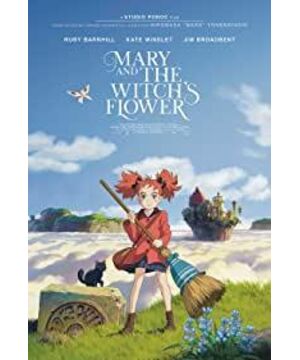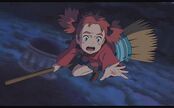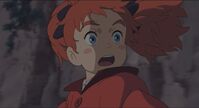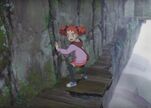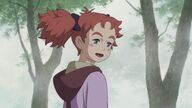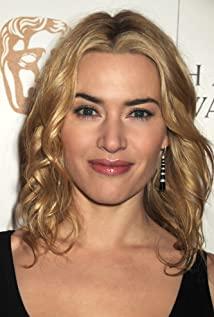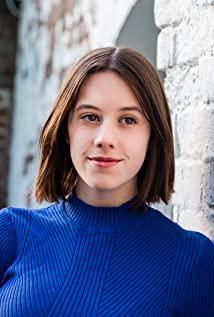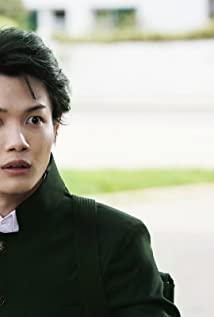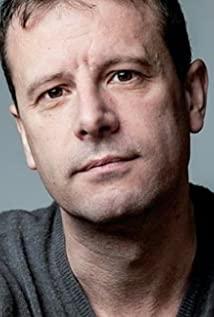The review written on April 24 was not published until today. . .
The following content is what I wrote after watching online resources on April 24th, 4 days before the domestic release (4.28)!
First of all, I'm sorry I couldn't help but read the online resources 4 days before the domestic release (4.28)! (Like when I watched "Your Name", I will go to the theater to make up the ticket when it is released!)
I have been looking forward to this work since I learned about it last year, but in recent years, although more Japanese animation films have been introduced into China, the progress is really too slow!
Basically, it takes more than half a year for the domestic release to be released in Japan before it has the opportunity to enter the domestic release (it seems that there are very few such films released simultaneously?)
Knowing this work is because of "Mirin Hongchang" and knowing "Mirin Hongchang" because of "Arrietty of Borrowing Things" and knowing "Arrietty of Borrowing Things" because of Studio Ghibli - Palace Master Zaki Hayao (Haha, what a twist!)
Next, let’s talk about the feeling after watching this work, there are spoilers carefully!
This "Mary and the Witch's Flower" should be regarded as "Mirin Hongchang"'s first work in the true sense after he quit Studio Ghibli, right?
Since he was born in "Studio Ghibli" and was apprenticed to "Master Hayao Miyazaki", although it is a work after exiting Studio Ghibli, "Mary and the Witch's Flower" can still see the full palace Hayao Saki's fairy tale style!
When I saw the image and the tone and voice of the gardener "Zebeti" in the red house that appeared at the beginning of the film at 00:07:30, I instantly felt a little familiar. Is the character image of "Ti" very similar to "Master Hayao Miyazaki"?
(Is it the original form?)
After watching the whole film later, I have my own understanding!
The gardener "Zebetti" in the film can be said to be a turning point in the plot of the film. He told the heroine Mary that "flying at night" is the flower of the witch!
There is this scene:
The heroine Marie saw that the gardener "Zebetti" was tidying up the courtyard, tying the flowers and the pillars together with lines and then tying a loose bow. After seeing this, the heroine Marie curiously and enthusiastically expressed her idea of helping to arrange the flowers. !
So the gardener "Zebetti" hesitated for a moment, then took out the line from his pocket and gave it to her. The heroine Mary happily said "thank you" and then started to search like the gardener "Zebetti". Flowers learn to tie them together!
But since it was her first homework, the heroine Marie used too much force when tying the bow, and broke both the flowers!
At this time, the heroine Mary immediately showed a very disappointed expression and said, "I'm sorry for that." After that, the gardener "Zebetti" came over and said helplessly: "I know, children and dogs are not suitable for cleaning. Garden!"
Later, although the hostess Mary bowed her head and walked away, she immediately saw a lot of leaves falling on the ground. It happened that there was a broom nearby, so she was dissatisfied and picked up the broom that did not match her height. Get up!
And while scanning, he said: "Look, you can still do it if you want to do it, but it's a bit big and hard to handle."
Then the heroine Mary accidentally tripped her foot and fell to the ground. She happened to be sitting on a wooden board, and the other end of the wooden board was a frame with leaves that had been swept and collected, just like the principle of a seesaw. As soon as Mary sat down, the whole frame of leaves was pushed up and buckled upside down on the head of the hostess! (Ha ha)
Back to the topic, why do I say this, because when I watched this, I included the character of the gardener "Zebetti" and this plot, and then I wondered if the director was telling his own experience in this plot?
As mentioned earlier, this "Mary and the Witch's Flower" should be regarded as the first work of "Mirin Hongchang" in the true sense after he quit Studio Ghibli, and the mentor of the director "Mirin Hongchang" is "Miyazaki". "Master Jun"
So I guess it will be the gardener "Zebetti" on behalf of the teacher: "Master Hayao Miyazaki" and the heroine Mary on behalf of the director: "Mirin Hongchang"?
This plot seems to be the director telling us the story of him and his master "Master Hayao Miyazaki"? Or do you also want to show a plot to the master "Master Hayao Miyazaki"?
Baidu searched, although when the film was just released last year, someone asked "Master Hayao Miyazaki" if he had seen the film? "Master Miyazaki" commented at the time that "Mary and the Witch's Flower" said: "I don't watch it! You are working hard"
(The following paragraph is taken from Tencent Entertainment News (text/Hu Mengying) on April 21: http://ent.qq.com/a/20180422/009822.htm )
However, when the director held a screening event in Shanghai, he revealed that in the process of making this film, "Master Hayao Miyazaki" still gave him many practical and constructive opinions, and also encouraged him to insist on self-creation and maximize himself. style of.
Not only that, during the production of the film, Hayao Miyazaki also made a special trip to visit them at Pulka Studio with the bread from Studio Ghibli, and asked about the production progress of "Mary and the Witch's Flower".
When the film was finally finished, Miyazaki also said that he was really happy and proud that they could complete a masterpiece alone. The hidden master-disciple relationship is also quite touching.
Although my ability to express may be limited, the above-mentioned plot of the gardener "Zebetti" and the heroine Mary does not show that the director wants to express his gratitude to his mentor "Miyazaki Hayao"!
However, when I saw the subtitles at the end of the film, the column of "Thank you" began to appear at 01:42:03 seconds, and three familiar names appeared: "Takahata Isao", "Miyazaki Hayao", "Suzuki Toshio"
Isao Takahata (TAT)
Hayao Miyazaki (Master does not need to introduce too much)
Toshio Suzuki (President of Ghibli / familiar producer)
Although it is not clear whether there is any order in the ranking, the name of "Master Miyazaki" ranks in the middle of the three, which means the so-called C position that was popular for some time last year!
This makes me even more sure that the director of the film, "Mr. Mirin Hongchang" wants to express his gratitude to "Miyazaki-sama"!
Maybe it's because I've only watched it once. There are still many things I don't understand about this film. I hope the boss will explain it!
1. Regarding the family of the heroine Mary, it seems that the parents did not show up until the end! It's just that I mentioned at the beginning that I've come back for a while. I thought there was an Easter egg at the end about the story of the heroine starting school and the reunion of her parents, but unfortunately it didn't!
2. Grandma Charlotte, the hostess of the red house, is a relative of the hostess Mary? Wikipedia says aunt?
3. Grandma Charlotte had the same red hair as the current heroine Mary when she was young. Why does her hair turn pink and white when she is old? (Because of age, there is still no magic power, is it not a witch?)
4. When Grandma Charlotte looked at the heroine Mary, didn't she feel like her younger self? (Is it inherited across generations? Why does the heroine Mary look so similar to Grandma Charlotte when she was young?)
5. There is no time node in the film. I thought the heroine was the reincarnation of the red-haired witch at the beginning, but I didn't expect it to be not, but the witch's niece?
6. The caretaker "Flanagan" of the broom hut has no specific introduction, but acts as a novice guide, and appears to help the heroine Mary at the juncture of the heroine Mary's crisis a total of 3 times. It seems that when she was young Is it just that you are always messing with justice?
Dr. D said at 01:12:00 in this film "that guy still hasn't changed at all"!
7. At 00:45:41 in this film, when the heroine Mary opened the magic book "The Essence of Spells" for the first time, there was a mantra injected into the forehead of the heroine Mary on the cover. This feature was originally thought to be injected. Fortunately, the magic of the whole book is useful later? But it didn't show up later!
Could it be that the incantation injected at that time was simply magic that allowed the heroine Mary to understand the words of the magical world?
8. In the end, the heroine and the hero worked together to use the magic of "Removing All Magic Spells" in "The Essence of Spells" and said, "All magic disappears, this world doesn't need any magic"
I thought that after starting here, all the magic will disappear from this world, but I didn't expect that it would be slapped in the face within a few seconds. This TM just lifted all the magic at that time, right?
So why add the phrase "this world doesn't need any magic"? Is there something wrong with the translation I read or...?
9. The witch's flower "flying at night" should be very important to the principal and Dr. D in the magical world. Don't they know that it only blooms once every 7 years? And haven't looked for this flower for decades?
10. Regarding the familiar, there is a familiar species in this work, but in the whole article, it seems that only the black cat beside the heroine Mary, who is defined as a familiar in their mouths, has never been seen. The familiar appeared?
11. The hand of the person who is enchanted by the witch's flower "night flight" will have flower patterns. Haven't the principal and Dr. D seen it before?
12. Regarding the question of the world view of this work, it seems that the world view is not fully explained or is it that I do not understand it?
Without a detailed explanation of the real world view and the magical world view, it seems that the magical world of this film only mainly introduces the magic school and the hometown of Grandma Charlotte?
Are there no other towns and living inhabitants in the wizarding world? Where are the new students recruited each year? Is it a real world filter?
I thought that the time in the magical world and the time in the real world are similar to "one year in the sky, one day on the ground"? It wasn't!
So the magical world is just a small gap in the real world? Or just two different worlds in the same time and space? Magic can also be used in the real world!
The above, a little spoiler, the big guys who understand my 12 questions, welcome to answer!
View more about Mary and the Witch's Flower reviews


